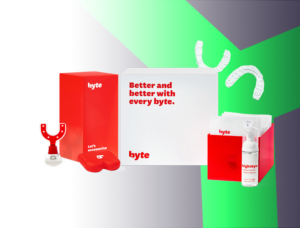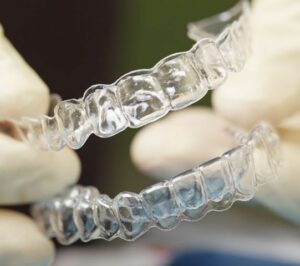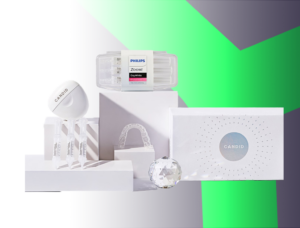
A passive aligner acts as a clear retainer during tooth-straightening treatments. It maintains the alignment of treated teeth while guiding other teeth into the proper position during orthodontic treatment. Unlike their active counterparts, passive aligners don’t actively move teeth but maintain their pre-adjusted positions.
It is achieved in one arch, while the other might experience active movement from an aligner. Maintaining one arch isn’t insignificant to teeth movement. This article is all about explaining how passive aligners contribute to long-term oral health and well-being.
What Does Passive Aligner Mean?
It is important to learn about how do teeth move with aligners while understanding the mechanism of passive aligners. The name “passive” points to the role of these trays in playing an inactive role as opposed to active aligners. They stabilize straightened teeth while other teeth are actively shifted into their ideal positions.
The key difference between passive aligners and braces lies in their mechanism of action. Unlike traditional braces that apply constant force, passive aligners hold teeth in place with gentle pressure. While braces actively move teeth through forceful adjustments, passive aligners simply maintain their current alignment.
Advantages of Passive Aligners
Aligners are one of the most effective and cheap ways to straighten teeth, but sometimes only the top or bottom teeth need to be straightened. Adjusting one set of teeth might trigger unwanted changes in the other, affecting the overall alignment and potentially undoing the existing proper positioning of the bottom teeth.
This is why dentists recommend passive aligners. They align one set of teeth while the other ones are secured in their proper places. It minimizes gum disease and decay risks because if the other teeth start moving, it might cause inflammation and worsen oral hygiene.
Passive aligners maintain the progress made on already straightened teeth, ensuring the final result matches the treatment plan. Above all, they enable effective, comfortable orthodontic experiences.
Considerations Before Choosing a Passive Aligner
The factors you must consider when choosing passive aligners are quite similar to those of active aligners. This is not surprising, since they differ only in function, while the material requirements remain the same. Here are the main things to consider.
Material: Ensure passive aligners are made from food-grade silicone or Styrene Copolymer, providing safe and effective use.
Durability: Opt for durable aligners capable of lasting through one aligner tray cycle.
Cost: While generally affordable, prices may vary based on brand and quantity.
Eco-friendliness: Biodegradable options minimize environmental impact.
Consult your dentist or orthodontist before buying aligners to ensure suitability for your treatment. Personalized dental assessments create tailored plans, addressing your unique needs and laying the foundation for successful treatment. The use of passive aligners is one such personalized need.
Remote or in-office consultations also enable progress tracking and early issue detection, ensuring treatment efficacy and alignment preservation. When using passive aligners, concerns like pain, discomfort, and nausea may arise. Alternative methods like aligner chewies or pain relievers can ease discomfort.
TOP 3 Passive Aligners
Below I have selected the top three passive aligners that can significantly enhance and support your aligner treatment journey.



Byte
Byte products boast a blend of cutting-edge technology and affordability. With Byte, you get personalized treatment plans, a HyperByte device to speed up tooth movement, and assessments from experienced dental professionals. ByteMe app tracks progress, making aligner wear convenient and enjoyable.
If tech-driven efficiency and budget-friendliness resonate with you, Byte would be the best option for you.
AlignerCo
AlignerCo prioritizes dentist consultations with their hybrid direct-to-dentist model. Instead of DIY treatment plans, you collaborate with a licensed dentist throughout your journey. This personalized approach offers peace of mind and expert guidance, making AlignerCo aligners ideal for those seeking close professional support.
Candid
Candid Aligners’ premium service includes in-person scans and unlimited refinements, ensuring a high-quality result. If you’re looking for a celebrity-worthy smile backed by professional expertise, Candid aligner might be the answer you’ve been waiting for.
Choosing the right passive aligner is vital for a successful treatment. Consider factors like function, effectiveness, quality, and maintenance. Remember, the best aligner for you depends on your individual needs and preferences. Do your research, ask questions, and choose an aligner that meets your smile goals.
Maintenance and Care Tips for Passive Aligners
Now that you’re familiar with the importance of passive aligners, you might be curious about how to clean my aligners?
Keeping your passive aligners clean and in tip-top shape is crucial for a smooth and successful orthodontic journey. Dirty aligners, passive or not, are an oral hazard that can breed bacteria and cause bigger issues than they aim to solve. Here are a few simple ways to clean passive aligners.
Gently brush aligners with a soft-bristled toothbrush and non-abrasive toothpaste after meals. Deep clean once a week by soaking them in a denture cleaner or mild dish soap solution for 15-20 mins.
For stubborn stains, soak in a mix of one part white vinegar and three parts water for 20 minutes. Rinse aligners thoroughly before and after use, then dry with a lint-free cloth.
You should always store aligners in their case when not in use to prevent damage and dust. Avoid exposing aligners to extreme temperatures or harsh chemicals, as it can damage them.
Conclusion
Passive aligners gently hold teeth in place while an active appliance shifts other teeth into their ideal positions. They offer numerous benefits, including reduced gum disease risk, lower tooth decay risk, and treatment outcome preservation.
With proper care and informed decision-making, passive aligners can help you achieve a healthy, beautiful smile that lasts a lifetime.



